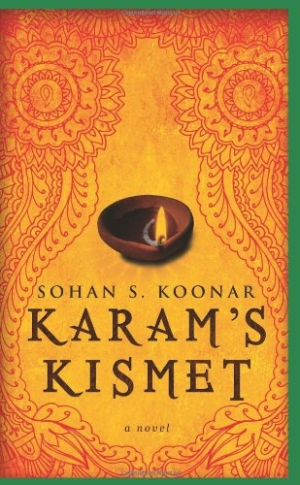
Karam's Kismet
Karam Pardesi is “the reluctant Midas; it seemed that everything he touched turned to gold.” In this historical novel of a young man whose fortunes change as the world changes, Sohan S. Koonar has created a sensual India and a cerebral Canada, connected by an island of good karma and sharp business acumen in the person of Karam.
Beginning in 1938, Karam’s Kismet traces the life of a boy born into the Chura (sweeper) caste in pre-independence India. His birth is marked by a small gift from a dying guru, Sant Baba, so his mother makes a shrine for the saint and tends it all her life. Ordinarily, such a low-caste boy as Karam would have no hope for changes to his circumstances, but his fate is unusual and remarkable: first, being allowed to go to newly formed schools in the more egalitarian India, then being taken under the wing of an elderly British doctor to study medicine, then being sent to Canada, and eventually partnering with a Jewish businessman in the medical lab business.
The partnership slowly gains purchase as the two men prosper beyond their wildest dreams, with each new challenge leading to decisions that garner them greater wealth and fame. Karam becomes known as a Chura who overcame his humble origins. He is honored in India, which has also prospered from Karam’s shared wealth and where he still visits his family. By the 1970s, Karam’s business is international and his vision universal; as he always counsels his Chura kin, “Cling to the old ways and lose.”
In the little village where he was born, Karam’s mother tends the shrine of Sant Baba, ensuring that it is honored and revered in the region. The novel ends with readers seeing the inner reality of her devotion and its mystical link to her son’s rise to fame and fortune.
As the events of Karam’s life unfold, the author guides readers skillfully through the maze of world events, especially the changes that blast through India after independence. Though the country is different, Koonar—who, like his novel’s hero, was born in India and now resides in Canada—makes it clear that the stigma of caste (along with religious and linguistic differences) remains among his countrymen, keeping them socially backward and influencing even the smallest matters, such as who can offer, and who can accept, a cup of tea.
Koonar’s prose is powerful and evocative, his plot never lagging. When Karam (whose name is, of course, a rearrangement of the word “karma”) returns to India for the first time after eight years abroad, he experiences what so many expatriates confront as they disembark: “India assaulted Karam’s senses the moment the airplane’s door opened to the early morning breeze of New Delhi … the humidity and the heat hit him like a wave … Rather than becoming nauseous, he was strangely exhilarated.” Entering the terminal Karam realizes that “Nothing had changed! The coolies assaulted the passengers like a swarm of locusts.”
Though Koonar is a relatively unknown writer at this time, it is not unreasonable to predict a trajectory, impelled by this panoramic and very human saga, which will bring his name into the realm of well-known and respected writers. In Koonar’s writing there is a distinct connection to noted expatriate Indian authors like R. K. Narayan and V. S. Naipaul. One hopes that nothing will hold this book back from the success it deserves.
Reviewed by
Barbara Bamberger Scott
Disclosure: This article is not an endorsement, but a review. The publisher of this book provided free copies of the book and paid a small fee to have their book reviewed by a professional reviewer. Foreword Reviews and Clarion Reviews make no guarantee that the publisher will receive a positive review. Foreword Magazine, Inc. is disclosing this in accordance with the Federal Trade Commission’s 16 CFR, Part 255.
